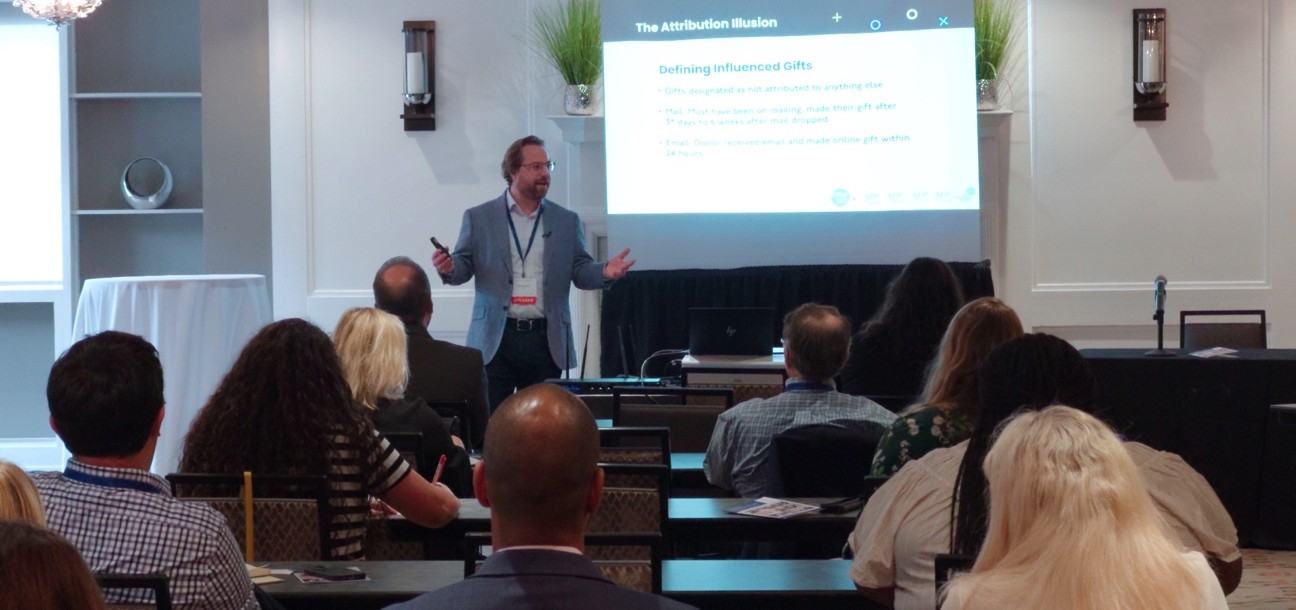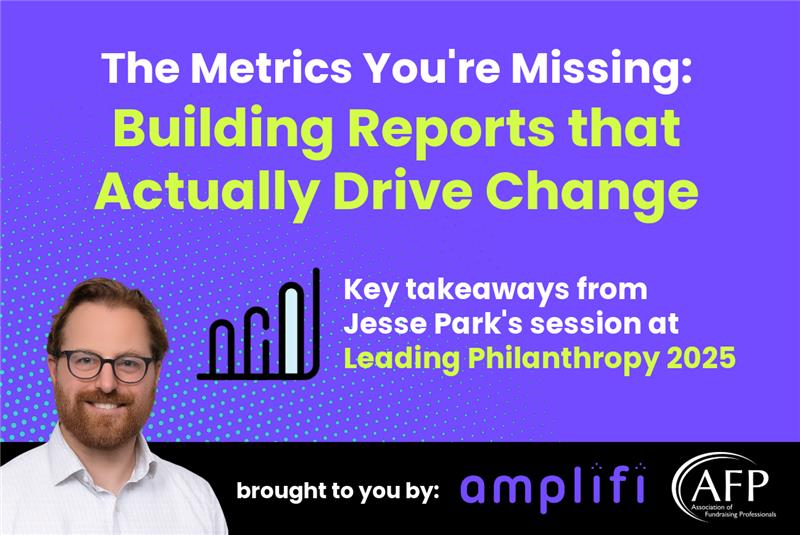Intentionally focusing on data-driven communications can seem scary to many nonprofits. We’ve become accustomed to standard metric reports in the performance dashboards built into our donor management systems. And we’re comfortable doing things the way we’ve always done them.
And yet, retention rates are stagnant, revenue feels unpredictable, and you may be struggling to translate data into decisions. If this sounds familiar, it’s time to ask yourself, “do our reports actually drive change?” and “am I missing something?”
The reality is most organizations focus on reports that only track performance.
However, the real value of reporting comes in when you shift your thinking from “what happened?” to “what should we do next?”
The following insights were shared as part of our highly acclaimed session, The Metrics You’re Missing: Building Reports That Actually Drive Change, at AFP GPC’s Leading Philanthropy Conference last week.
Good reporting starts with curiosity.
Every actionable report begins with asking the right questions. But fundraisers often skip this critical step and just keep looking at the same dashboards and spreadsheets every month.
They steer their way through the data without a clear roadmap. And they only begin asking questions when things don’t line up as expected. As a result, too many nonprofits are reacting to their data and scrambling to adjust on the fly.
So, have you asked yourself:
-
- Which donors are most responsive?
- Are we making the right asks?
- Do donors increase support over time?
- Are donors giving in response to our emails?

Avoid the attribution illusion.
The first question most fundraisers ask themselves is, “how did the campaign do?”
And that’s where attribution comes in. It’s all about the way you connect a donor’s gift back to a specific campaign or appeal.
On the surface, it should be pretty simple. You run a report of all the donations given to a specific campaign in your donor management system. Those are gifts that are obviously attributable to the campaign.
But they don’t tell the whole story.
As a result, it’s not surprising to see nonprofits not understanding where upwards of 40 percent of revenue came from.
This is what we call the attribution illusion. Attributable gifts only take your reports so far. So how do we account for these “un-attributable” gifts? And what do we call them?
Here’s a few key principles to better account for these “influenced” gifts:
-
- They are clearly not attributable to any other campaign or solicitation.
- If you recently sent a mailing, they were A, on the mailing list and B, made a gift within a limited window of time after the mailing went out either by mail or online.
- If you recently sent out an email, they received the email and made a gift online the same day.
Depending on your situation, there may be tighter or looser standards, or even additional principles, to account for your “influenced” gifts.
If you follow overly strict definitions of attribution, you risk neglecting the larger story of how donors were influenced. Those “unattributed” or “whitemail” gifts still matter. So, your reports should account for them.
It’s about shifting back into that curious mindset rather than focusing on narrow windows.
LEARN MORE: Achieving more with less amid economic uncertainty.

Understanding donor behavior.
Behavioral reports will help you move past campaign snapshots and into the bigger picture. They’ll show whether your ask is effective, whether donors are giving more or less over time, and which lapsed or at-risk donors deserve the most attention.
So, keep an eye out for emerging patterns that can help reshape your strategy.
If you use variable asks, when was the last time you looked at how many donors were giving more than your base ask? Your ask string may be too aggressive if donors are consistently giving less than that. Or, if most individuals are giving more but overall fundraising dollars are down, you’re probably looking at the loss of a major donor, not a widespread decline that requires an overhaul of your general program.
We all want to increase retention and focus efforts on LYBUNT (Last Year But Unfortunately Not This Year) donors. But are they all really equal? With better reporting, you can zero in on donors who have a strong history of giving multiple gifts over several years. This is often a small enough number that you can call each one to understand why they haven’t given yet this year.
With better reporting, you can adjust your asks in real time and prioritize who you solicit to make the most of your fundraising program.
LEARN MORE: Are you accommodating your donors’ preferences?

Email reports don’t stop at the dashboard.
Email metrics seem to be the most straightforward. Unfortunately, they’re also the easiest to misinterpret. And too many organizations only focus on open or click rates.
But those numbers don’t tell the whole story. It’s critical to understand how people engage after that initial click and whether they actually follow through with a donation.
Stronger reporting will reveal patterns that surface-level dashboards can’t.
A strong click rate without corresponding donations may point to problems with your donation page, not the email itself. Perhaps certain subject line styles, send times, or sender identities generate consistently higher engagement from specific segments of your audience.
Yet, donor conversion rates are probably the most overlooked metric for nonprofits. And without it, you can’t see how many donors who clicked through gave to your nonprofit.
That gap can lead you to focus energy on the wrong part of your program. You may end up tweaking subject lines when the real issue is friction on your donation page or calls-to-action, for example.
That’s why effective email reporting goes beyond counting opens and clicks. These reports should show how your audience interacts throughout the entire donation process, so you can pinpoint exactly where improvements will make the biggest difference.
LEARN MORE: 4 ways nonprofits use data to optimize email outreach.
Build a culture of curiosity.
Fundraising is hard enough without wasting time on numbers that don’t move the needle.
The right reports can show you which donors are most likely to respond, help you refine your ask strategy, and flag the areas that are causing you to miss out on gifts. And most importantly, they shift reporting from a backward-looking scorecard into a forward-facing roadmap.
At the end of the day, reporting is more about curiosity than data. The most successful nonprofits don’t treat their reports as boxes to check on a to do list. They see them as an opportunity to discover, ask, and answer their most important questions.
Click here to schedule a chat and talk through your reporting strategy with us!









